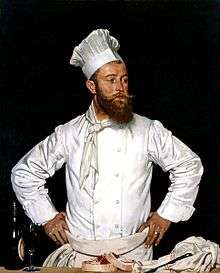Chef's uniform
The traditional chef's uniform (or chef's whites) includes a toque blanche ("white hat"), white double-breasted jacket, pants in a black-and-white houndstooth pattern, and apron. It is a common occupational uniform in the Western world.

Description
The toque is a chef's hat that dates back to the 16th century.[1][2] Different heights may indicate rank within a kitchen,[1] and they are designed to prevent hair from falling into the food when cooking.[2] The 100 folds of the chefs’ toque are said to represent the many different ways a chef knows to cook eggs according to the website Reluctant Gourmet.[3]
In more traditional restaurants, especially traditional French restaurants, the white chef’s coat is standard and considered part of a traditional uniform and as a practical chef's garment. Most serious chefs wear white coats to signify the importance and high regard of their profession. The thick cotton cloth protects from the heat of stoves and ovens and protects from splattering of boiling liquids.[4] The double breasted jacket is used to add protection to the wearer's chest and stomach area from burns from splashing liquids. This can also be reversed to hide stains.[4] Knotted cloth buttons were used to survive frequent washing and contact with hot items. White is intended to signify cleanliness as well as repelling heat from the kitchen and is generally worn by highly visible head chefs.[3] Increasingly, other colours such as black are becoming popular as well.
The long, wide chef's apron provides many advantages. It is primarily worn for safety purposes. The apron will take the main impact, should hot liquid spill over a pot as the Chef is carrying it, and can be quickly removed to get it away from the undergarments and legs. The apron is worn long to just below the knee to protect the upper part of the legs. Traditionally, the purpose of the apron was also to protect the wearer's garments from food stains and smells.[5] It also used to provide a convenient cloth with which to wipe messy hands or to dry washed hands, although this would be considered unhygienic now.[5] Sometimes, an apron will contain pockets, enabling a chef to easily carry the tools of their trade.[6]
These embellishments of uniform also serve as an indicator between the bounds of salaried, and casual or part-time staff.[4][7]
Chefs' clothing remains a standard in the food industry. The tradition of wearing this type of clothing dates back to the mid-19th century. Marie-Antoine Carême, a popular French chef, is credited with developing the current chef’s uniform. The toques were already used, but he sought a uniform to honour the chef. White was chosen for the chef's coat to signify cleanliness. Later, the French master chef, Georges Auguste Escoffier, brought the traditional chef's coat to London, managing the restaurants at the Savoy Hotel and then at the Carlton Hotel.
References
- Engber, Daniel (28 March 2014). "Who Made That Chef's Toque?". The New York Times Magazine. Retrieved 25 July 2018.
- "A History Of The Chef's Hat". Culinary Arts. Auguste Escoffier School of Culinary Arts. 6 January 2016. Retrieved 25 July 2018.
- Jones, G. Stephen (8 June 2010). "Chef Hat – History & Facts". The Reluctant Gourmet. Retrieved 5 Nov 2018.
- Blackmon, David (5 November 2008). "Kitchen uniforms: Why do chefs wear white?". Chicago Defender. Archived from the original on 10 June 2014.
- "Cooking Aprons: An Overview". BestBuy Uniforms. 2013. Archived from the original on 2 February 2014.
- "Chef Aprons". ApronWarehouse. 2018. Retrieved 25 July 2018.
- Mayer, Caroline E. (4 April 1991). "Traditional chef's hat stirs kitchen debate". Chicago Sun-Times. Archived from the original on 10 June 2014.